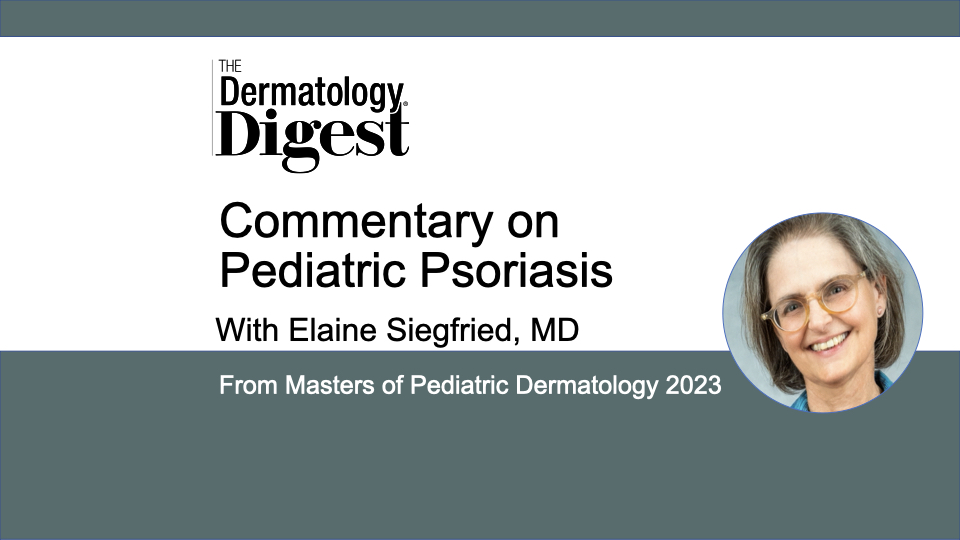Dr. Elaine Siegfried discusses pediatric psoriasis, including nuances for diagnosis, treatment approach, and genetic variants.
Elaine Siegfried, MD, Professor of Pediatrics and Dermatology at Cardinal Glennon Children’s Hospital, Saint Louis University, St. Louis, Missouri
“In a recent talk about summarizing pediatric psoriasis for dermatologists … I spent quite a bit of time talking about diagnosis because the clinical features of pediatric psoriasis are a little different than psoriasis in adults,” said Elaine Siegfried, MD, who presented on pediatric psoriasis at the Masters of Pediatric Dermatology Symposium in Miami Beach, Florida.
Among the unique features is location. In children, the face and diaper areas are sites of predilection. As in adults, psoriasis in infants and children is sharply circumscribed but as the scale is often less prominent, sometimes misdiagnosed as eczema, said Dr. Siegfried.
“It’s important to distinguish psoriasis from eczema because effective treatment differs. For mild cases, initial treatment with a topical corticosteroid can improve both conditions. But psoriasis doesn’t respond as well to topical corticosteroid monotherapy and rebound worsening off treatment is common. Effective topical treatment for psoriasis often requires combination treatment, classically a corticosteroid combined with activated vitamin D, for example, or steroid sparing agents like pimecrolimus, tacrolimus, or some of the newer anti-inflammatory agents.”
In addition to the face and diaper areas, a thorough skin exam for other, sometimes subtle sites of predilection that can help support the diagnosis of psoriasis are the skin folds, palms, soles, nails, posterior auricular creases, and scalp, said Dr. Siegfried, adding “I consider cradle cap to be a manifestation of sebopsoriasis in infants.”
Still other interesting sites of predilection include one that Dr. Siegfried calls the “thumb sign.”
“Localized thumb involvement is a manifestation of Koebnerized psoriasis. The medial upper eyelid is another commonly affected site often assumed to be dermatitis.”
A less recognized sign of psoriasis in children as “psoriatic otitis externa,” said Dr. Siegfried.
“In some cases, this is the only manifestation of psoriasis. This condition often presents with itching and discomfort in their ear canals, prompting ENT referral and mechanical debridement, which then sets up a vicious cycle of Koebnerization. I’ve seen many children referred by our otolaryngologists, who have been frustrated by patients requiring repeated debridement. The debris in their canals is more likely scale than cerumen.”
Treatment with a combination topical corticosteroid and calcipotriene or calcitriol solution works well for psoriatic otitis externa, said Dr. Siegfried.
“Scalp psoriasis is another diagnostic and therapeutic challenge. Scalp scale with associated alopecia is not necessarily tinea capitis.”
Psoriasis can be associated with hair loss, but tinea capitis can also Koebnerize psoriasis, said Dr. Siegfried.
“These conditions can coexist. So, I often obtain swab samples for fungal culture from scalps and look for other evidence supporting the possibility of tinea capitis. The sensitivity of scalp fungal cultures may not be high enough to establish the diagnosis. In rare cases, when the alopecia is severe, scalp biopsy is the most reliable way to distinguish between the two.”
Pustular Psoriasis Update
Pustular psoriasis has been in the news with the approval of spesolimab (Spevigo®; Boehringer Ingelheim Pharmacuticals, Germany) in September of last year, an interleukin (IL)-36 receptor blocker indicated for pustular psoriasis in adults, said Dr. Siegfried.
“Spesolimab dramatically improved pustular psoriasis after only one intravenous infusion in a small cohort of severely affected adults, which earned fast track FDA approval. Although data is limited in adults and trials have only recently included adolescents, targeting this pathway has supported understanding of the different inflammatory mechanisms underlying pustular psoriasis compared to standard plaque-type psoriasis.”
Inherited variants of pustular psoriasis characteristically present in infancy, including deficiency of IL-36 receptor antagonist (DITRA) and deficiency of IL-1 receptor antagonist (DIRA), said Dr. Siegfried.
“These are two autoinflammatory conditions also feature extracutaneous inflammation, including recurrent fevers, sterile osteomyelitis, and pulmonary findings. They are probably candidates for treatment with IL-36 blockade.”
Another variant, the CARD14 mutation, looks a little like pityriasis rubra pilaris but is an another unusual genetically based variant of psoriasis, she said.
“The best treatment for these genotypes has not been defined and is often complicated by restricted access to biologics. I presented a case during my lecture, of a 4 year old with CARD14 that responded beautifully to acitretin. Pustular psoriasis can respond well to acitretin, as well. So, in the absence of FDA-approved treatments, acitretin is a readily available, effective option.”
Disclosures: Dr. Siegfried has consulting, speaking or other ties with Regeneron, Sanofi Genzyme, Verrica, AbbVie, ASLAN Pharmaceuticals, Boehringer Ingelheim, Cara Therapeutics, Incyte, Leo, Novan, Novartis, Pfizer, Pierre Fabre, UCB, AI Therapeutics, Lilly, and Janssen.


